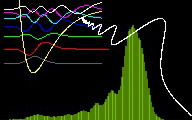|
Interatomic Coulombic Decay
In addition to photoemision from an excited atom and the emission of an Auger-electron, Interatomic Coulombis decay provides a third, additional decay mechanism, predicted by Cederbaum et al. In that case the deexcitation energy is transferred to a neighboring atom, which releases it by emission of its most loosely bound electron.
 |
Photoionization of the helium dimer – how to ionize two atoms with a single photon
Phys. Rev. Lett. 104, 153401 (2010)
Phys. Rev. Lett. 104, 133401 (2010)
|
| |
 |
Experimental Observation of Interatomic Coulombic Decay (ICD) in Neon Dimers
Phys. Rev. Lett., 93(2004)163401
|
| |
 |
Intermolecular Coulombic Decay in water dimers -
observation of an ultrafast decay mechanism
Nature Physics (2010), doi:10.1038/NPHYS1498
or the original submitted version of this paper (pdf)
|
| |
 |
The breakup of helium dimers investigated in fast ion collisions
|
| |
 |
Enhanced production of low energy electrons by alpha particle impact
PNAS (2011) vol. 108, no. 29, 11821-11824
|
| |
 |
A molecular movie of interatomic Coulombic decay
PRL 111, 093401 (2013)
|
| |
 |
A Single Atom Antenna
Physical Review Letters, 111, 233004 (2013)
|
| |
 |
Resonant Auger decay driving intermolecular Coulombic decay in molecular dimers
Nature 505, 664 (2014)
DOI: 10.1038/nature12927
|
|
|
